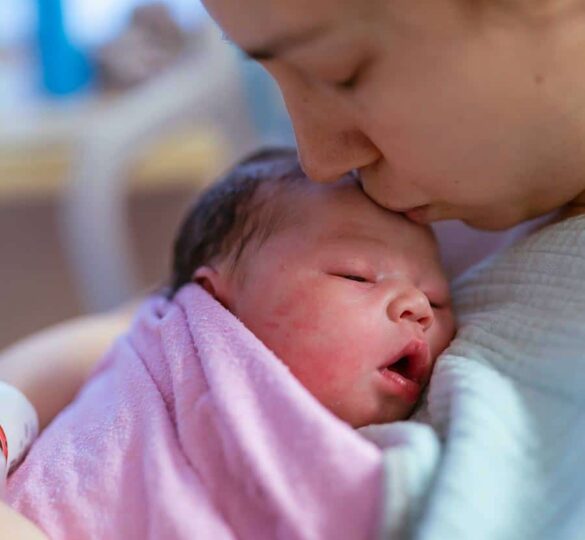Early Warning Signs of Childhood Glaucoma: A Guide for Parents

While an ophthalmologist is responsible for diagnosing and treating childhood glaucoma, parents play a crucial role in early detection and intervention.
Childhood glaucoma, or pediatric glaucoma, is a rare yet severe eye condition that, if left unchecked, could lead to vision loss. Early detection and intervention are critical to managing the condition effectively to avoid lasting damage to a child’s sight. Continue reading to learn about the signs of childhood glaucoma and treatments that could help protect your child’s vision.
What Is Childhood Glaucoma?
Glaucoma is a group of eye diseases that damage the optic nerve, which transmits visual information from the eye to the brain. In contrast to most forms of adult glaucoma, which typically develop due to age-related changes in the eye, childhood glaucoma is often present from birth (congenital) or can appear in the early years of a child’s life. Early onset can be linked to developmental issues of the eye’s drainage system.
The primary hallmark of childhood glaucoma is increased intraocular pressure (IOP). IOP is the fluid pressure inside the eye, and when it’s too high, it can compress and damage the delicate fibers of the optic nerve. Over time, this increased pressure can lead to significant visual impairment. Detecting and managing IOP in children is crucial because the damage caused by elevated eye pressure can be both severe and permanent.
Management of childhood glaucoma often requires surgical intervention to correct the structural abnormalities in the eye that impede normal fluid drainage. Regular monitoring and treatment are critical to controlling IOP and preventing vision loss. Pediatric glaucoma treatment is usually managed by a specialized team that includes a pediatric ophthalmologist and a pediatric glaucoma specialist capable of addressing the unique challenges of care.
Types of Childhood Glaucoma
Congenital glaucoma, also known as infantile glaucoma, is typically diagnosed within the first year of life and affects approximately 1 in every 10,000 births in the United States.
Juvenile glaucoma can develop at any age during childhood. Unlike infants with congenital glaucoma, older children are usually able to describe their discomfort and symptoms more clearly.
Secondary glaucoma can also arise at any time during childhood and is often associated with other ocular abnormalities, such as aniridia, or systemic conditions like Sturge-Weber syndrome, Juvenile Idiopathic Arthritis, Axenfeld-Rieger syndrome, or Marfan syndrome. Additionally, secondary glaucoma may develop after trauma, eye surgery (such as cataract removal), or steroid treatment.
Early Signs and Symptoms of Childhood Glaucoma
Although glaucoma is rare in children, its signs and symptoms often differ from those seen in adults. While an ophthalmologist is responsible for diagnosing and treating childhood glaucoma, parents play a crucial role in early detection and intervention.
Recognizing the signs of childhood glaucoma can be challenging because the symptoms often present subtly and can be mistaken for less severe conditions. Early detection is vital for better outcomes through timely treatment. Symptoms can vary significantly depending on the type of glaucoma and its underlying causes. Here are some of the most common early warning signs:
- Excessive Tearing — An unusual amount of tearing is one of the primary indicators of glaucoma in infants. While it’s common for babies to tear occasionally, excessive tearing that seems persistent or is accompanied by other symptoms might suggest elevated pressure in the eyes, characteristic of glaucoma.
- Cloudy, Hazy, or Opaque Eyes — The appearance of a cloudy or grey cornea is a critical sign. This cloudiness results from the buildup of pressure within the eye, affecting the cornea’s transparency and making it look hazy or opaque. This symptom is particularly concerning because it indicates a significant disturbance in the eye’s normal pressure and fluid balance.
- Sensitivity to Light (Photophobia) — Children with glaucoma may show signs of discomfort in normal lighting, a condition known as photophobia. This sensitivity can cause them to squint, be irritable when exposed to light, or prefer dimly lit environments. This symptom arises because high IOP may cause structural changes in the cornea.
- Enlarged Eyes (Buphthalmos) — One of the more visually noticeable signs of childhood glaucoma is buphthalmos, where the eyes appear larger than usual. This enlargement occurs because increased IOP causes the immature fibers in the young eye to stretch and expand. The enlargement is typically seen, but often, the family believes the child has “big beautiful eyes.”
- Vision Problems — Children with glaucoma might show signs of difficulty focusing on or tracking objects. These vision issues can manifest as struggling to maintain eye contact, difficulty recognizing familiar faces from a distance, or inability to respond to visual stimuli.
Each of these symptoms, especially when they appear together, warrants immediate medical attention to confirm an issue and if glaucoma begins appropriate treatment. Early diagnosis and management are essential to prevent long-term visual impairment in children with glaucoma.
When to Seek Medical Attention
Ensuring the preservation of vision relies on early diagnosis and treatment. Parents should promptly consult a pediatric ophthalmologist if they observe any of the mentioned symptoms or have concerns about their child’s eye health. Early detection and proper care provide the best opportunity to prevent vision loss.
If you notice any of the above symptoms in your child, it’s vital to schedule an appointment with an ophthalmologist as soon as possible. Eye doctors can use specialized tests to check for elevated eye pressure and examine the optic nerve for signs of glaucoma damage.
Diagnosis of childhood glaucoma involves a thorough eye examination by a pediatric ophthalmologist. Key diagnostic tests include:
- IOP Measurement: Pressure inside the eye can be measured with special instruments.
- Examination of the Optic Nerve: Damage to the optic nerve can be assessed through imaging tests.
- Cornea Measurement: The size and appearance of the cornea can be assessed to help diagnose glaucoma in infants and young children.
The importance of regular eye exams cannot be overstated, as early diagnosis can significantly improve the prognosis for children with glaucoma.
Treatment Options for Childhood Glaucoma
Treatment for conditions that lead to increased IOP typically begins with surgical interventions designed to correct the underlying structural abnormalities of the eye. It might involve procedures to enhance fluid drainage or reduce fluid production within the eye, thereby alleviating pressure.
In addition to surgery, an ophthalmologist might prescribe medications to manage symptoms and regulate eye pressure more effectively. These medications could include eye drops or oral medications that help lower pressure within the eye or improve fluid drainage.
It’s essential to start treatment early to prevent the progression of vision loss and to optimize the chances of a successful outcome. Promptly addressing the condition ensures that therapeutic measures can be most effective, helping to preserve vision and overall eye health.
Regular follow-up is crucial even after glaucoma has been controlled. With timely treatment and periodic follow-up to monitor vision changes and other eye functions, many children go on to live normal lives with good vision.
Help Us Provide Hope
While childhood glaucoma is rare, its potential impact on a child’s vision can be profound. Recognizing the signs early and seeking professional evaluation can significantly affect a child’s quality of life. If you suspect your child is displaying signs of glaucoma, consult a pediatric ophthalmologist immediately.
The diligent work of researchers continues to lead to a better understanding of glaucoma every day. As a result, there’s great hope for new and improved treatments, including superior drug delivery methods, laser treatments, and less invasive surgical techniques. You can help make that happen!
Your support can help dedicated researchers continue to discover cures for glaucoma. Your donations also give hope to those living with glaucoma and accelerate our search for a cure.
Posted June 4, 2024. Reviewed for medical accuracy by Robert Feldman, MD. Special thanks to Lauren S. Blieden, MD for contributing to this article.

Robert Feldman, MD
Robert Feldman, MD is a Professor at the McGovern Medical School, Ruiz Department of Ophthalmology and Visual Sciences, Cizik Eye Clinic, University of Texas Health Sciences Center in Houston, Texas.